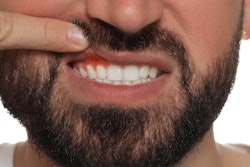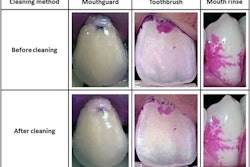
A toothpaste containing extra-virgin olive oil (EVOO), xylitol, and betaine may improve gingivitis better than commercial antigingivitis toothpastes. The results of a randomized clinical trial were published on April 18 in Scientific Reports.
Patients with gingivitis who brushed three times daily with a toothpaste containing EVOO experienced less gingival bleeding, reduced supragingival biofilms, and an increase in salivary pH, the authors wrote.
“Superior clinical outcomes were obtained at 4 months in patients with gingivitis who brushed their teeth three times daily with the toothpaste containing EVOO, xylitol, and betaine in comparison to a placebo toothpaste and commercial antigingivitis toothpaste,” wrote the authors, led by Dr. Antonio Magán-Fernandez of the University of Granada in Spain.
Until this clinical trial, only one in vitro study has explored the antimicrobial effects of a toothpaste containing EVOO.
To explore whether using a toothpaste containing EVOO, xylitol, and betaine improved gingivitis better than a placebo and commercial toothpastes, researchers conducted a clinical trial involving 61 people. The patients with gingivitis were randomly separated into three groups. There were 20 in the test toothpaste group, 20 in the commercial toothpaste group, and 21 in the placebo toothpaste group.
Those in test group brushed with a toothpaste that contained EVOO, xylitol, betaine, water, hydrated silica, glycerol, sodium monofluorophosphate, titanium dioxide, sodium benzoate, aroma, potassium sorbate, and stevia. The placebo toothpaste contained the same ingredients as the experimental toothpaste minus the EVOO extract, xylitol, and betaine. Finally, the commercial toothpaste contained water, hydrolyzed hydrogenated starch, hydrated silica, zinc citrate, sodium lauryl sulfate, aroma, cellulose gum, sodium fluoride, sodium saccharin, tocopherol acetate, and titanium dioxide, according to the study.
To assess the percentage of supragingival biofilm and gingival bleeding, patients were evaluated at baseline, two months, and four months, and nonstimulated salivary flow and salivary pH were measured.
Compared to the placebo toothpaste group, the test group showed significantly greater decreases in gingival bleeding between four months and baseline (p = 0.02) and in dental biofilm between two months and baseline (p = 0.02) and between four months and baseline (p = 0.01). In the test group, salivary flow significantly increased between month two and baseline (p = 0.01) while pH alkalization was significantly greater between month four and baseline versus the commercial toothpaste group (p = 0.01). Salivary flow was close to significantly greater in the test group versus the placebo group (p = 0.06), the authors wrote.
The study had limitations, including its small sample size, the authors noted. Additional studies using larger samples should be conducted to verify the results, they wrote.
“The toothpaste with EVOO, xylitol, and betaine obtained the best outcomes in patients with gingivitis, who showed reductions in gingival bleeding and supragingival biofilm and an increase in pH at 4 months in comparison to a commercial toothpaste,” Magan-Fernandez et al concluded.




















